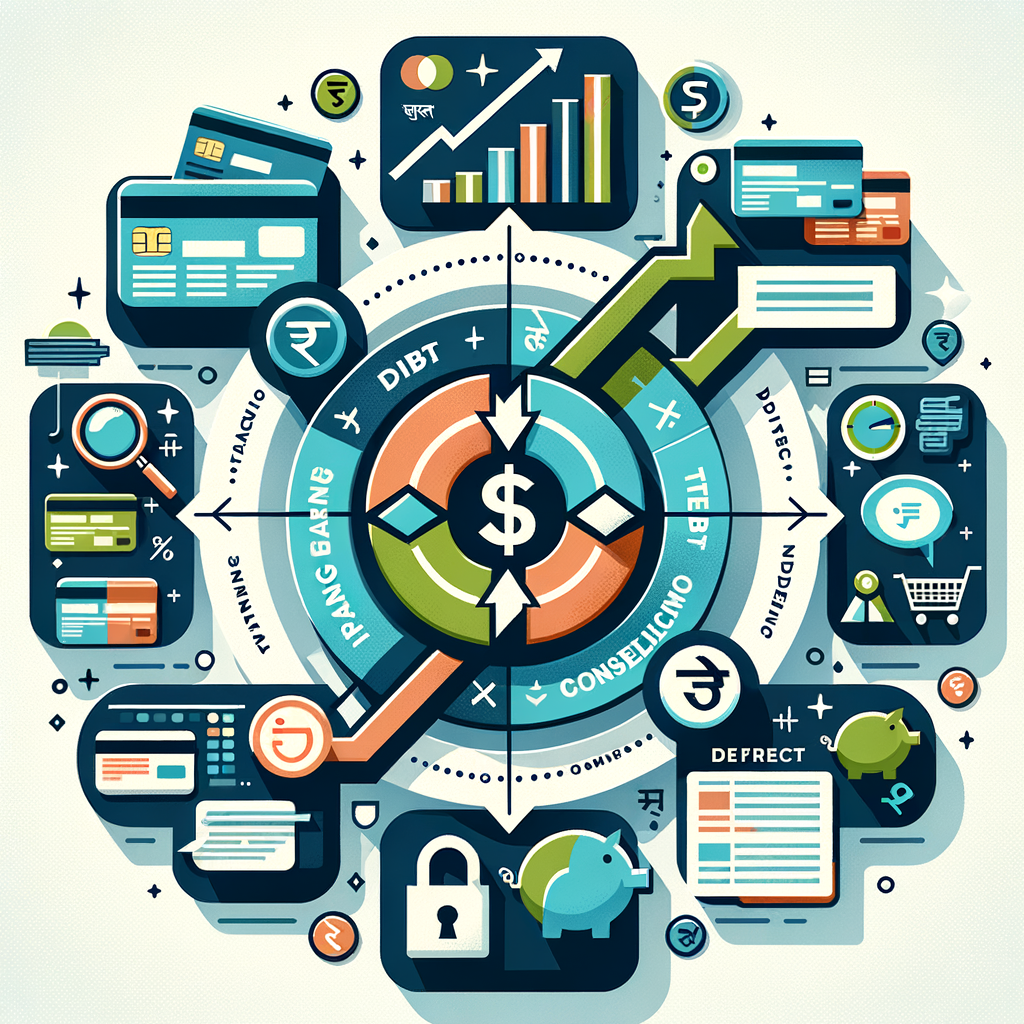Managing Multiple Credit Cards: A Debt Reduction Approach
Festive sales, online shopping deals, and tempting bank promotions make it incredibly easy for Indians to accumulate a wallet full of credit cards. Each one promises unique rewards, from airline miles to instant discounts. While this feels like smart financial planning initially, the convenience can quickly spiral into a significant burden. Suddenly, you’re juggling multiple due dates, high-interest payments, and mounting stress. This is where a clear plan for managing multiple credit cards becomes not just helpful, but essential for your financial well-being. This comprehensive guide is designed to provide you with actionable, India-focused debt reduction strategies to help you break free from the debt cycle, regain control of your finances, and improve your credit health. Effective credit card debt management India is the first step towards a secure financial future.
The Reality of Credit Card Debt in India
The proliferation of credit cards in India is a double-edged sword. On one hand, they offer unparalleled convenience and access to a world of rewards. On the other, they can pave the way for a dangerous debt trap if not handled with discipline. Understanding the forces at play is crucial for any individual looking to master credit card management for Indians. The problem often begins subtly, driven by savvy marketing and our own psychological biases, but the consequences, such as crippling interest charges and a damaged CIBIL score, are very real. Before you can devise a solution, it’s important to recognize how you got here in the first place.
The Allure of Rewards, Offers, and Cashbacks
Indian banks and financial institutions are masters at creating highly specific and attractive credit card products. There is a card for every lifestyle and spending habit. You might get a co-branded travel card for flight benefits and lounge access, another for a fuel surcharge waiver on your daily commute, and a third that offers exclusive discounts on your favourite e-commerce platform. This strategy encourages consumers to sign up for multiple cards to “maximise” benefits. While it seems logical to use the right card for the right purchase, this can quickly complicate your finances, making it difficult to track overall spending and leading to the challenge of managing multiple credit cards India-wide.
The “Buy Now, Pay Later” Mindset
There is a distinct psychological difference between handing over physical cash and simply tapping a plastic card. The act of swiping a card feels less immediate and less “real,” making it easier to overspend without feeling the immediate financial pinch. This “buy now, pay later” mentality disconnects the pleasure of purchasing from the pain of payment. Over time, this behaviour can lead to lifestyle inflation, where your spending consistently exceeds your income. Small, impulsive purchases add up, and before you know it, you are carrying a substantial balance across several cards, turning a tool of convenience into a source of significant financial stress.
The Hidden Dangers: High APRs and Minimum Payment Traps
The most perilous aspect of credit card debt lies in its high interest rates and the deceptive nature of the “minimum amount due.” In India, the Annual Percentage Rate (APR) on credit cards can be astonishingly high, often ranging from 40% to 45% per year. This interest is charged on your outstanding balance if you don’t pay the full amount by the due date. The “minimum payment trap” is particularly dangerous. Banks typically require a minimum payment of only 5% of the outstanding balance. While paying this small amount helps you avoid late fees, the remaining 95% of your balance continues to accrue interest at a very high rate.
For example, imagine you have an outstanding balance of ₹50,000 on a card with a 42% APR. If you only pay the minimum amount each month, it could take you over a decade to clear the debt, and you would end up paying more in interest than your original purchase amount. This is how many people remain in a perpetual cycle of debt.
A Strategic Approach to Managing Multiple Credit Cards and Reducing Debt
Getting out of credit card debt requires more than just willpower; it requires a concrete, strategic plan. By breaking down the problem into manageable steps, you can systematically tackle your balances and pave the way for financial freedom. This section outlines a clear, step-by-step approach to help you organize your finances and choose the most effective debt reduction strategies India has to offer. This methodical process is the cornerstone of successful credit card debt management India.
Step 1: Get Organized – Create a Debt Inventory
You cannot fight an enemy you cannot see. The first and most critical step is to get a crystal-clear picture of your total debt. This involves creating a debt inventory. Open a simple spreadsheet or use a notebook and list all your credit cards. For each card, create columns for the following information:
- Credit Card Issuer: (e.g., HDFC Bank, SBI Card, ICICI Bank)
- Outstanding Balance: The total amount you owe.
- Interest Rate (APR): Find this on your monthly statement.
- Minimum Payment Due: The minimum amount required each month.
- Payment Due Date: The last day to pay without incurring a late fee.
| Credit Card Issuer | Outstanding Balance | Interest Rate (APR) | Minimum Payment Due | Payment Due Date |
|---|---|---|---|---|
| HDFC Bank | ₹75,000 | 42% | ₹3,750 | 5th of the month |
| SBI Card | ₹40,000 | 38% | ₹2,000 | 15th of the month |
| ICICI Amazon Pay | ₹25,000 | 40% | ₹1,250 | 20th of the month |
This simple table transforms a chaotic mess of bills into a single, manageable dashboard. It gives you a complete overview of your financial situation and is the foundation for all strategies to pay off credit cards India.
Step 2: Choose Your Debt Payoff Strategy
Once you have your debt inventory, it’s time to choose a payoff strategy. The two most popular and effective methods are the Debt Avalanche and the Debt Snowball. Your choice will depend on your personality and what motivates you.
- The Debt Avalanche Method: With this method, you make the minimum payment on all your cards and then channel all your extra funds towards the card with the highest interest rate. Once that card is paid off, you take the entire amount you were paying on it (minimum + extra) and apply it to the card with the next-highest interest rate. This process continues until all your debts are cleared. Mathematically, this method saves you the most money in interest over time.
- The Debt Snowball Method: This strategy focuses on psychological wins. You make the minimum payment on all your cards and put all your extra funds towards the card with the smallest balance, regardless of its interest rate. Once that smallest debt is eliminated, you feel a sense of accomplishment and momentum. You then roll the payment you were making on that card into the payment for the next-smallest balance. This creates a “snowball” effect that keeps you motivated.
| Strategy | Focus | Best For | Key Advantage |
|---|---|---|---|
| Debt Avalanche | Highest Interest Rate First | The mathematically inclined and highly disciplined. | Saves the most money in interest payments over time. |
| Debt Snowball | Smallest Balance First | Those who need quick wins and motivation to stay on track. | Builds momentum and provides powerful psychological boosts. |
Ultimately, the best strategy is the one you will stick with. If you are driven by numbers and efficiency, choose the Avalanche. If you need early successes to stay motivated, the Snowball is your best bet. For a detailed comparison, explore our guide on Debt Snowball vs. Debt Avalanche: Which Strategy Is Best for You?.
Step 3: Stop Accumulating New Debt
This step is simple but non-negotiable. While you are actively trying to pay off your debt, you must stop adding to it. This means putting your credit cards away—literally. Store them in a drawer or a safe place where you won’t be tempted to use them for daily purchases. Switch to using your debit card or UPI for all your expenses. This forces you to spend only the money you actually have in your bank account, breaking the cycle of borrowing. This behavioural shift is fundamental to answering the question of how to reduce credit card debt India. It may feel restrictive at first, but it is a temporary measure that is crucial for your long-term financial health.
Step 4: Explore Debt Consolidation Options
If you have high-interest debt across multiple cards, managing various payments can be overwhelming. Debt consolidation is a strategy where you combine multiple debts into a single, new loan, ideally with a lower interest rate. This simplifies your payments into one monthly EMI and can save you a significant amount of money. The two primary options in India are:
- Balance Transfer: Many banks offer balance transfer credit cards that come with a 0% or very low introductory APR for a specific period (e.g., 6-12 months). You can transfer the outstanding balances from your high-interest cards to this new card.
- Pros: You get an interest-free period to aggressively pay down your principal balance.
- Cons: There is usually a one-time processing fee (1-3% of the transferred amount). You must be disciplined enough to pay off the entire balance before the promotional period ends, or the interest rate will jump to a very high standard rate.
- Personal Loan: You can take out a personal loan from a bank or NBFC at a fixed, lower interest rate (typically 11-16%) and use the funds to pay off all your credit card balances at once.
- Pros: You get a single, fixed monthly EMI, making budgeting easier. The interest rate is almost always significantly lower than credit card APRs.
- Cons: You need a good credit score to qualify for a low-interest personal loan. It replaces one form of debt with another, so discipline is still required. To learn more about this option, read The Ultimate Guide to Debt Consolidation Loans.
Long-Term Habits for Effective Credit Card Usage
Once you have a plan to reduce your debt, it’s time to focus on building sustainable habits for the future. The goal is to transform credit cards from a source of debt into a powerful financial tool. Adopting these effective credit card usage tips India will not only keep you out of debt but also help you build a strong financial profile. The long-term benefits of managing credit cards India include a better CIBIL score, access to better loan terms, and greater financial peace of mind.
Master the Credit Utilisation Ratio (CUR)
Your Credit Utilisation Ratio (CUR) is one of the most important factors affecting your CIBIL score. It is the percentage of your total available credit that you are currently using. The formula is: CUR = (Total Outstanding Balance on All Cards / Total Credit Limit on All Cards) x 100. For a healthy credit score, it is crucial to keep your CUR below 30%. A high CUR suggests to lenders that you are over-reliant on credit and may be a higher-risk borrower. Regularly monitoring your credit report is a key part of this process; you can learn more in our guide on How to Track Your Credit History Using Your PAN Card Via CIBIL.
For example, if you have two credit cards, one with a limit of ₹1,00,000 and the other with a limit of ₹50,000, your total credit limit is ₹1,50,000. If your combined outstanding balance is ₹30,000, your CUR is (30,000 / 1,50,000) * 100 = 20%, which is excellent. For more details on this topic, you can read our guide on How to Improve Your CIBIL Score.
Automate Payments to Avoid Late Fees
Late payments are a triple threat: they incur hefty late fees, add high interest charges, and significantly damage your CIBIL score. The easiest way to avoid this is to automate your payments. Log in to your net banking portal and set up an auto-debit instruction for at least the minimum amount due on each of your credit cards. This acts as a safety net, ensuring you never miss a payment deadline. However, always aim to manually pay the full statement balance before the due date to avoid interest charges altogether.
Strategic Card Usage
Instead of using your cards randomly, assign a specific purpose to each one to maximize rewards and maintain control over your spending. This strategy turns your wallet into a well-organized financial toolkit. For instance:
- Use your Amazon ICICI Card exclusively for purchases on Amazon to get 5% cashback.
- Use your BPCL SBI Card only for filling fuel to get value back on fuel expenses.
- Use your HDFC Diners Club Card for travel bookings and dining to maximize reward points in those categories.
This approach not only ensures you are earning the most rewards but also makes it easier to track your spending in different categories.
When and How to Close a Credit Card
After paying off a card, your first instinct might be to close the account. However, this can sometimes hurt your credit score. A significant factor in your score is the length of your credit history. Closing your oldest credit card shortens this history and can cause a dip in your score. Therefore, it is generally advisable to keep your oldest, no-annual-fee card open, even if you use it sparingly for a small purchase every few months to keep it active. If you must close cards, start with the newer ones, especially those that come with high annual fees and offer benefits you no longer use.
Conclusion
The journey from credit card debt to financial control is a marathon, not a sprint. It begins with the crucial step of managing multiple credit cards with a clear and deliberate strategy. By creating a debt inventory, choosing a payoff method like the Debt Avalanche or Snowball, halting new debt accumulation, and building healthy long-term habits, you can transform your relationship with credit. Remember, credit cards are not inherently bad; they are financial tools. The key lies in using them wisely to build your wealth and credit profile, rather than letting them become a source of stress and debt. With discipline and the right plan, you can take charge of your finances and achieve lasting security.
Feeling overwhelmed with debt and financial planning? The experts at TaxRobo can help you create a personalized financial roadmap. Contact us today for assistance with everything from tax planning to debt management.
Frequently Asked Questions (FAQs)
Q1. Is a balance transfer a good idea for managing credit card debt in India?
Answer: Yes, a balance transfer can be a very effective tool for credit card debt management India, but only if you are disciplined. It allows you to move your high-interest debt to a new card with a 0% introductory interest rate for a promotional period. This gives you a window to pay down the principal amount aggressively. However, always check the one-time processing fee and make sure you have a solid plan to pay off the entire balance before the promotional period ends, as the interest rate will increase significantly afterward.
Q2. How does having multiple credit cards affect my CIBIL score?
Answer: Having multiple credit cards can have both positive and negative effects on your CIBIL score. On the positive side, it increases your total available credit limit, which can help lower your overall credit utilisation ratio (CUR), a key factor in your score. On the negative side, if not managed well, it can lead to overspending, high balances, and missed payments, all of which will severely damage your credit score. The key is responsible management.
Q3. Should I close my credit cards after paying them off?
Answer: It’s generally not recommended to close your oldest credit card account. The length of your credit history is an important factor in your CIBIL score, and closing an old account can shorten it. Instead, consider closing newer credit cards that you don’t use often, especially if they have high annual fees. Keeping your oldest card open and using it for a small transaction periodically can help maintain a healthy credit history.
Q4. What is the fastest way to reduce credit card debt in India?
Answer: The fastest way to how to reduce credit card debt India involves a multi-pronged approach. First, use the Debt Avalanche method, which focuses on paying off the card with the highest interest rate first to save the most money. Second, drastically cut down on all non-essential spending and redirect that money towards your debt payments. Third, look for ways to temporarily increase your income, such as freelance work or selling unused items, and use all extra earnings to make larger payments on your credit card debt. Combining these strategies will accelerate your journey to becoming debt-free.



